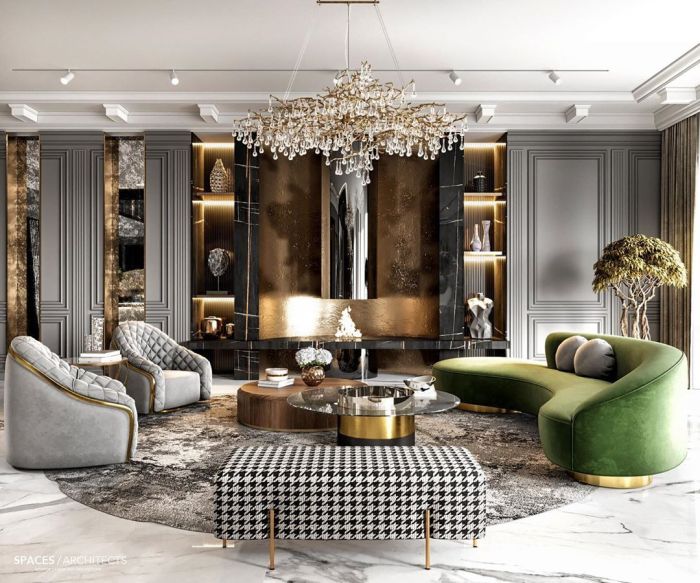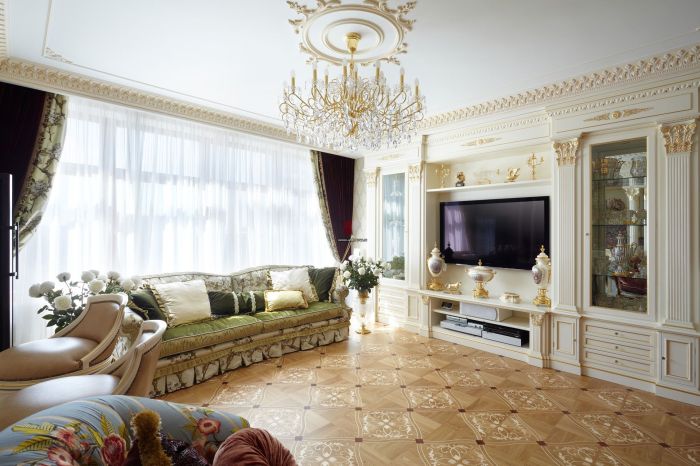Creating a Timeless Appeal: Classic Interior Design

Embark on a journey through the elegance and sophistication of classic interior design. From iconic furniture pieces to intricate details, explore the key elements that define this timeless style.
Delve into the world of classic interiors and discover how the perfect blend of materials, textures, and lighting can transform any space into a masterpiece of design.
Elements of Classic Interior Design
Classic interior design is known for its timeless elegance and sophisticated appeal. Some key characteristics of classic interior design include:
- Luxurious fabrics such as velvet, silk, and brocade
- Intricate details like ornate moldings, trim, and paneling
- Elegant furniture with curved lines and carved wood accents
- Symmetry and balance in the layout of the space
Typical color schemes used in classic interiors are often rich and warm, including deep reds, golds, blues, and greens. Neutral tones like cream, beige, and taupe are also commonly used as a backdrop to showcase the more vibrant colors.Common furniture styles in classic interior design include pieces inspired by historical periods such as the Baroque, Rococo, and Neoclassical eras.
Furniture often features ornate carvings, cabriole legs, and plush upholstery.Examples of classic interior design elements include:
Moldings
Crown moldings, chair rails, and baseboards add architectural interest to the space.
Arches
Arched doorways and windows create a sense of grandeur and elegance.
Columns
Columns can be used as decorative elements or to define different areas within a room.
Classic Interior Design Elements
- Ornate moldings, trim, and paneling
- Luxurious fabrics like velvet and silk
- Elegant furniture with carved wood accents
- Symmetry and balance in layout
Materials and Textures in Classic Interior Design

In classic interior design, the choice of materials and textures plays a crucial role in creating a timeless and elegant ambiance. Let's explore some of the popular materials and textures used in classic interiors.
Wood
Wood is a staple material in classic interior design, known for its warmth and versatility. It is often used for furniture, flooring, and decorative elements like paneling and moldings. The rich tones and natural textures of wood add a sense of luxury and sophistication to the space.
Marble
Marble is another favorite material in classic interiors, prized for its timeless beauty and durability. It is commonly used for countertops, flooring, and ornate details like fireplace surrounds and statues. The smooth texture and intricate veining of marble bring a sense of opulence to the design.
Rich Fabrics
Textiles like silk, velvet, and brocade are often used in classic interior design to add depth and richness to the space. These luxurious fabrics are used for upholstery, curtains, and decorative cushions, creating a sense of comfort and elegance.
Combining Textures
In classic interiors, a variety of textures are often combined to create a cohesive and harmonious look. For example, a mix of smooth marble, rich wood, and plush fabrics can add visual interest and depth to the design, enhancing its timeless appeal.
Intricate Patterns and Ornate Finishes
Details like intricate patterns and ornate finishes are key elements of classic interior design. From elaborate wallpaper designs to intricate carvings on furniture, these details add a sense of grandeur and sophistication to the space, elevating its overall aesthetic.
Furniture Selection for Classic Interiors

When it comes to creating a classic interior design, the selection of furniture plays a crucial role in setting the tone and overall aesthetic of the space. Classic interiors are known for their timeless elegance and sophistication, so choosing the right furniture pieces is essential to achieve that desired look.Quality craftsmanship is paramount when selecting furniture for a classic interior.
Classic furniture is often characterized by intricate detailing, fine materials, and impeccable construction. Investing in well-made pieces not only ensures durability but also adds a sense of luxury to the space.
Choosing Furniture Pieces
- Opt for pieces with traditional designs such as Queen Anne, Chippendale, or Louis XVI styles.
- Look for furniture made of high-quality materials like wood, leather, and upholstery fabrics in rich tones.
- Consider incorporating antique or vintage pieces to add character and charm to the space.
Importance of Quality Craftsmanship
Quality craftsmanship is essential in classic furniture as it reflects attention to detail and longevity. Pieces crafted with precision and care not only enhance the overall aesthetic but also showcase the artistry of skilled artisans.
Iconic Furniture Pieces
-
The Chesterfield sofa: Known for its deep button-tufting and rolled arms, this iconic piece exudes classic elegance.
-
The Barcelona chair: Designed by Ludwig Mies van der Rohe, this modern classic seamlessly blends style and comfort in a classic interior.
-
The Eames Lounge Chair: A timeless design by Charles and Ray Eames, this chair is a symbol of mid-century modern sophistication.
Enhancing Aesthetic with Furniture Layout
The layout of furniture in a classic interior can greatly impact the overall aesthetic of the room. Consider symmetry, balance, and scale when arranging furniture to create a harmonious and visually appealing space. Position key pieces such as a grand dining table or a statement sofa as focal points to anchor the room's design.
Lighting and Accessories in Classic Interior Design
Lighting and accessories play a crucial role in enhancing the classic design elements of a space, adding a touch of elegance and sophistication. By carefully selecting lighting fixtures and accessories, you can create a timeless and luxurious ambiance in classic interiors.
Role of Lighting in Accentuating Classic Design Elements
Proper lighting can highlight the architectural details and decorative elements of classic interiors, such as intricate moldings, ornate furniture, and rich textures. It helps create a warm and inviting atmosphere while showcasing the beauty of the space.
Use of Accessories in Classic Interiors
In classic interiors, accessories like chandeliers, mirrors, and artwork play a significant role in elevating the overall aesthetic. Chandeliers add a touch of grandeur and act as a focal point in the room. Mirrors can enhance the sense of space and reflect light, making the room appear larger and brighter.
Artwork adds personality and character to the space, showcasing the homeowner's taste and style.
Examples of Lighting Fixtures Adding Elegance
- Crystal chandeliers: These timeless fixtures add a glamorous touch to classic interiors, reflecting light and creating a dazzling effect.
- Wall sconces: Elegant wall sconces can provide ambient lighting and accentuate architectural features like columns or alcoves.
- Table lamps: Classic table lamps with ornate bases and shades can add a touch of traditional charm to any room.
Tips for Selecting Accessories in Classic Interiors
When choosing accessories for classic interiors, opt for timeless pieces that complement the overall design scheme. Consider the scale of the accessories in relation to the size of the room, and ensure they enhance the classic aesthetic without overpowering the space.
Mix and match different accessories to create visual interest and balance in the room.
Ending Remarks
As we conclude our exploration of classic interior design, remember that the essence of this style lies in its ability to evoke a sense of tradition and luxury. By incorporating classic elements into your space, you can create a home that exudes timeless beauty and charm.
FAQ Insights
What are the typical color schemes used in classic interiors?
Classic interiors often feature neutral colors like cream, beige, and taupe, along with rich jewel tones like deep reds and blues.
How important is furniture layout in enhancing the classic aesthetic of a room?
The layout of furniture plays a crucial role in creating a cohesive and harmonious classic interior. Proper placement can emphasize the elegance of the design elements.
What role does lighting play in accentuating classic design elements?
Lighting is essential in highlighting key features of classic interiors, such as ornate finishes and architectural details, creating a warm and inviting ambiance.

